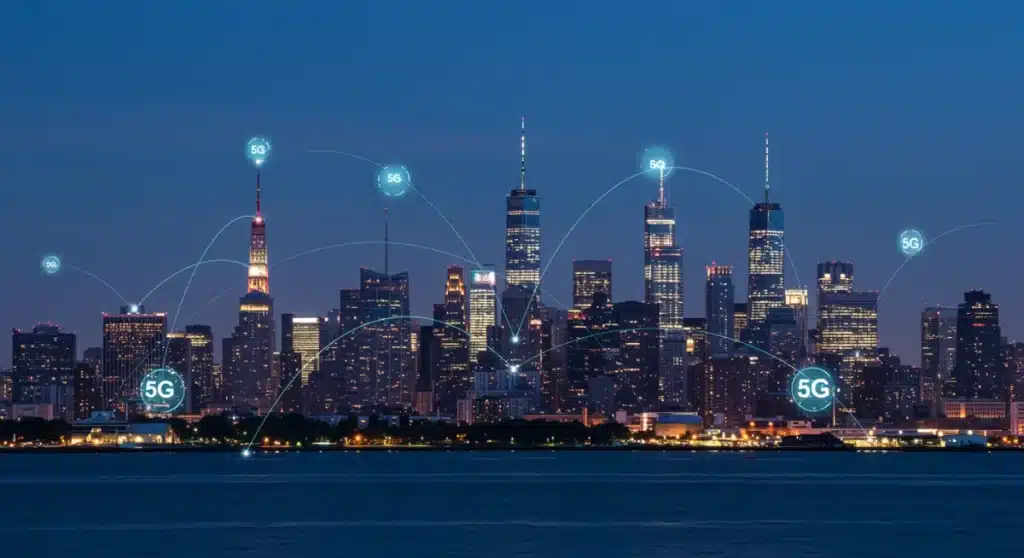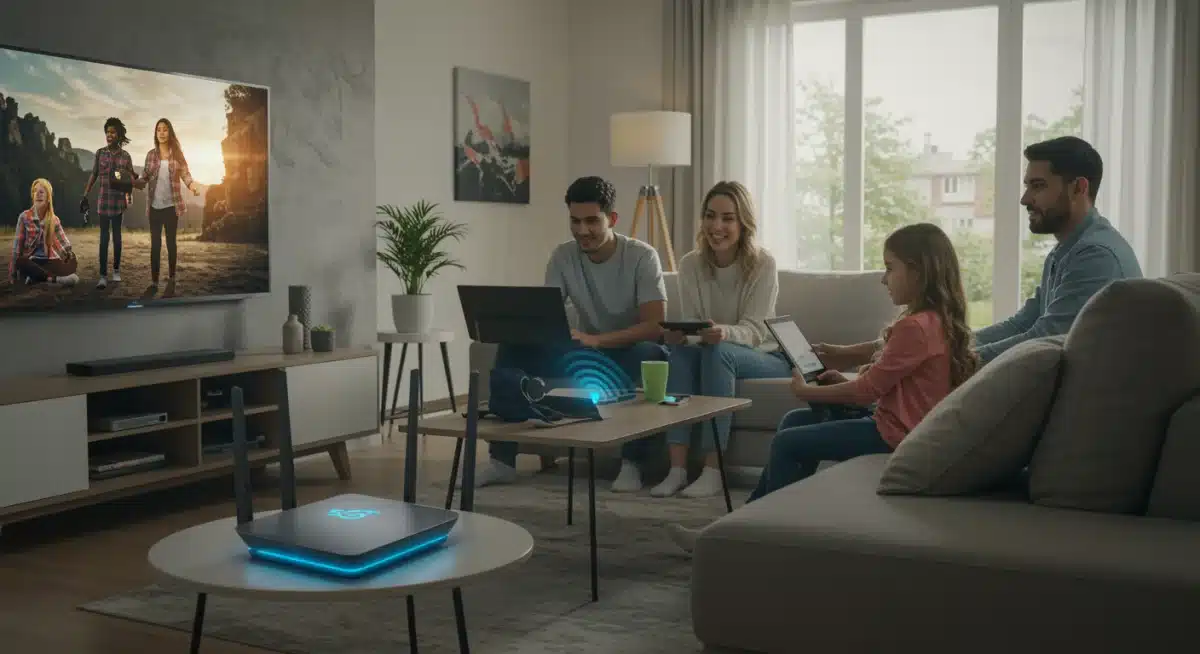Unlocking 5G’s Full Potential: A US Guide to Maximize Speed by 2025

To maximize 5G’s true potential and speed in the US by 2025, consumers and businesses must adopt optimized devices, choose appropriate plans, and leverage emerging network enhancements for unparalleled connectivity and innovation.
The promise of 5G has been a topic of intense discussion for years, and by 2025, its true potential is finally within reach for US consumers and businesses. This article explores practical solutions to help you maximize 5G speed, ensuring you harness the full power of this transformative technology.
Understanding the 5G Landscape in the US
The deployment of 5G in the United States has progressed significantly, but its capabilities are not uniformly distributed. Different types of 5G—low-band, mid-band, and high-band (mmWave)—offer varying speeds and coverage, impacting how users experience the technology. Understanding these distinctions is crucial for optimizing your 5G experience.
Low-band 5G, while offering extensive coverage, often provides speeds only marginally faster than advanced 4G LTE. Mid-band 5G, known as the ‘sweet spot,’ delivers a balance of speed and coverage, making it ideal for urban and suburban areas. High-band 5G, or mmWave, offers incredibly fast speeds but has limited range and struggles to penetrate obstacles, making it best suited for dense urban environments and specific venues.
The Three Tiers of 5G: Speed and Coverage
- Low-band 5G: Widespread coverage, speeds slightly better than 4G LTE, foundational for broad access.
- Mid-band 5G: Balanced performance, good speed and coverage, becoming the backbone of many networks.
- High-band (mmWave) 5G: Extremely high speeds, limited range, ideal for specific high-density areas.
As 2025 approaches, carriers are continually expanding their mid-band and mmWave deployments, which will significantly enhance the overall 5G experience. This tiered approach allows for a flexible and adaptable network that can cater to diverse user needs, from rural connectivity to ultra-fast urban experiences. Consumers and businesses need to be aware of their local network availability to make informed decisions about devices and plans.
The evolving 5G landscape means that simply having a 5G-capable device isn’t enough; understanding the type of 5G available in your area and how it impacts performance is key to truly maximizing its benefits. This knowledge empowers users to choose the right tools and strategies for their specific connectivity demands.
Optimizing Your Devices for Peak 5G Performance
Even with a robust 5G network, your device plays a critical role in how well you can access and utilize those speeds. Not all 5G-enabled devices are created equal, and several factors can influence their performance. Investing in the right hardware and maintaining it properly are essential steps to maximize 5G speed.
Modern smartphones and other devices are designed to support various 5G bands, but older models might have limitations. For instance, some early 5G phones might not support mmWave or certain mid-band frequencies that have become more prevalent. Ensuring your device is up-to-date with the latest software and firmware can also significantly improve its ability to connect efficiently and maintain high speeds.
Choosing the Right 5G Device
- Latest Chipsets: Opt for devices with the newest 5G modems and processors for optimal performance.
- Band Support: Verify that your device supports all major 5G bands, including mmWave and mid-band frequencies, relevant to your local area.
- Antenna Design: Advanced antenna arrays can significantly improve signal reception and data throughput.
Furthermore, device settings can impact 5G performance. Things like disabling low power modes, ensuring your operating system is updated, and managing background applications can free up resources, allowing your device to dedicate more power to maintaining a strong 5G connection. For businesses, this extends to dedicated 5G routers and IoT devices, where proper configuration and placement are paramount.
By carefully selecting and maintaining 5G-compatible devices, both consumers and businesses can ensure they are fully equipped to take advantage of the fastest available speeds. This proactive approach to hardware optimization forms the foundation for a superior 5G experience.
Selecting the Best 5G Plans and Carriers
Choosing the right 5G plan and carrier is as important as having a capable device. Different carriers offer varying levels of 5G coverage and speed, often tied to specific plans and pricing tiers. Understanding these options and matching them to your usage needs is crucial for maximizing your 5G investment.
Carriers in the US have distinct strengths in their 5G networks. Some excel in mmWave deployment in specific cities, while others have broader mid-band coverage. Researching carrier coverage maps for your primary locations (home, work, travel routes) is a vital first step. Don’t rely solely on advertised speeds; real-world performance can vary significantly based on location and network congestion.
Evaluating Carrier Offerings for Optimal Speed
- Coverage Maps: Check detailed 5G coverage maps for low-band, mid-band, and mmWave in your specific areas.
- Data Caps and Throttling: Understand any data limits or potential speed throttling after a certain usage threshold, which can impact consistent high speeds.
- Priority Data: Some premium plans offer priority data, meaning your speeds are less likely to be deprioritized during network congestion.

For businesses, dedicated 5G business plans often come with service level agreements (SLAs) and enhanced support, which can be critical for mission-critical applications. Considerations like fixed wireless access (FWA) plans for businesses in areas with limited fiber access can also leverage 5G to provide high-speed internet. Consumers should also look into bundled plans that include 5G home internet, potentially offering a cost-effective solution for whole-home connectivity.
Making an informed decision about your 5G plan involves more than just comparing price tags; it requires a deep dive into network performance, data policies, and specific features that align with your individual or business requirements to truly maximize 5G speed.
Leveraging 5G for Business Transformation and Growth
For US businesses, 5G isn’t just about faster downloads; it’s a foundational technology that can drive significant transformation and open new avenues for growth. By 2025, companies that strategically adopt 5G will gain a competitive edge through enhanced operational efficiency, innovative services, and improved customer experiences.
The low latency and high bandwidth of 5G enable applications that were previously impossible or impractical. This includes real-time data processing at the edge, supporting advanced IoT deployments, and facilitating augmented reality (AR) and virtual reality (VR) solutions for training, design, and customer engagement. Manufacturing, logistics, healthcare, and retail sectors are particularly poised to benefit.
Key Business Applications of Maximized 5G Speed
- Enhanced IoT and Edge Computing: Real-time data collection and analysis from countless sensors and devices, processed closer to the source for faster insights.
- Private 5G Networks: Dedicated, secure, and customizable networks for enterprises, offering unparalleled control and performance for critical operations.
- AR/VR for Training and Collaboration: Immersive experiences for remote assistance, product design, and employee training, reducing costs and improving effectiveness.
- Smart Logistics and Supply Chains: Real-time tracking, autonomous vehicles, and automated warehousing to optimize efficiency and reduce errors.
Implementing 5G requires a strategic roadmap, identifying specific business needs that 5G can address and integrating it with existing IT infrastructure. Businesses should also consider collaborating with network providers and technology partners to design and deploy tailored 5G solutions. The ability to process vast amounts of data quickly and reliably will empower businesses to make faster, more informed decisions, leading to increased productivity and new revenue streams.
Embracing 5G’s capabilities beyond simple speed upgrades will be a differentiator for businesses aiming for innovation and sustainable growth in the competitive US market by 2025.
Practical Tips for Consumers to Maximize 5G Speed
While businesses focus on large-scale deployments, individual consumers can also take several practical steps to ensure they are getting the most out of their 5G connection. Maximizing 5G speed at a personal level involves more than just having a 5G phone; it’s about optimizing your usage and environment.
One of the simplest yet most overlooked tips is understanding your signal. 5G, particularly mmWave, is highly directional and sensitive to obstacles. Moving closer to a 5G tower or finding a clear line of sight can dramatically improve speeds. Using a 5G signal strength app can help identify optimal locations within your home or office.
Everyday Strategies for Enhanced 5G Performance
- Device Placement: For 5G home internet, place the router in an open area, away from walls and large electronic devices.
- Software Updates: Regularly update your phone’s operating system and carrier settings to ensure optimal modem performance.
- App Management: Close unnecessary background apps that might consume bandwidth or slow down your device.
- Wi-Fi Offloading: Utilize Wi-Fi for non-critical tasks when available, reserving 5G for when its speed truly matters.

Additionally, consider investing in a 5G-compatible mesh Wi-Fi system for larger homes, especially if using 5G as your primary home internet connection. This can extend the high-speed 5G signal throughout your living space, ensuring consistent performance on all your devices. For mobile users, enabling Wi-Fi Calling when indoors can improve call quality and free up 5G bandwidth for data-intensive tasks.
By implementing these practical tips, consumers can significantly enhance their personal 5G experience, enjoying faster downloads, smoother streaming, and more reliable connectivity in their daily lives.
The Future of 5G: Beyond 2025 and Emerging Technologies
As we look beyond 2025, 5G’s evolution is far from complete. The initial rollout focused on speed and capacity, but future developments will unlock even more transformative capabilities, integrating seamlessly with other emerging technologies. Understanding these trends is crucial for staying ahead of the curve and continuing to maximize 5G speed and utility.
One significant area of development is 5G Advanced, or 5G-A, which will build upon the current 5G standards. 5G-A promises even lower latency, greater energy efficiency, and enhanced support for complex applications like extended reality (XR) and advanced industrial IoT. It will also improve integration with non-terrestrial networks (NTNs), such as satellite communication, extending 5G coverage to remote areas and enabling new global services.
Upcoming Innovations to Watch
- 5G Advanced (5G-A): The next evolution of 5G, offering ultra-low latency, energy efficiency, and enhanced XR support.
- Integrated Sensing and Communication (ISAC): 5G networks will not only communicate but also sense their environment, enabling new applications in smart cities and autonomous systems.
- AI Integration: Artificial intelligence will play a larger role in optimizing 5G networks, predicting traffic patterns, and dynamically allocating resources for peak performance.
- Quantum-Resistant Cryptography: Enhanced security protocols to protect 5G networks from future quantum computing threats.
Furthermore, the convergence of 5G with artificial intelligence (AI) and machine learning (ML) will lead to smarter, more adaptive networks. These intelligent networks will be able to dynamically optimize performance, predict demand, and even self-heal, ensuring consistent high speeds and reliability. The development of quantum-resistant cryptography will also become vital, safeguarding the vast amounts of data transmitted over 5G networks.
The journey of 5G is continuous, with ongoing research and development promising a future where connectivity is not just fast but also intelligent, ubiquitous, and deeply integrated into every aspect of our lives. Staying informed about these advancements will be key to unlocking the full, long-term potential of 5G.
Addressing Challenges and Ensuring Equitable Access
While the potential of 5G is immense, its widespread adoption and the ability for all US consumers and businesses to maximize 5G speed also face significant challenges. Addressing these hurdles, particularly those related to infrastructure, cost, and digital divide, is crucial for realizing a truly connected future.
The cost of deploying dense 5G networks, especially mmWave, is substantial. This often leads to uneven rollout, where urban centers receive priority, leaving rural and underserved areas with slower or no 5G access. Bridging this digital divide requires concerted efforts from government, carriers, and local communities to invest in infrastructure and innovative deployment models.
Overcoming Obstacles to Universal 5G Access
- Infrastructure Investment: Increased funding and incentives for carriers to expand 5G coverage to rural and underserved areas.
- Affordable Access: Development of more affordable 5G plans and devices to ensure broader consumer adoption.
- Permitting Streamlining: Simplifying the process for deploying small cells and other 5G infrastructure to accelerate rollout.
- Public-Private Partnerships: Collaboration between government entities and private companies to share costs and resources for network expansion.
Another challenge is consumer education. Many users may not understand the different types of 5G or how to optimize their devices and plans, leading to suboptimal experiences. Clear communication from carriers and public awareness campaigns are essential to help users understand how to truly maximize 5G speed and leverage its benefits. For businesses, the complexity of integrating 5G into existing systems can be a barrier, necessitating robust support and consulting services.
Ensuring equitable access and addressing these challenges will be critical for the US to fully capitalize on the transformative power of 5G, ensuring that its benefits are shared across all segments of society and economy by 2025 and beyond.
| Key Point | Brief Description |
|---|---|
| Device Optimization | Ensure your devices support all relevant 5G bands and are updated for peak performance. |
| Carrier & Plan Selection | Choose plans and carriers based on local coverage, data policies, and specific needs. |
| Business Integration | Leverage 5G for IoT, private networks, and AR/VR to drive business transformation. |
| Future Advancements | Look towards 5G Advanced and AI integration for even greater speed and capabilities beyond 2025. |
Frequently Asked Questions About Maximizing 5G Speed
The primary factor limiting 5G speed for most US consumers is often the type of 5G available in their area. Many regions primarily have low-band 5G, which offers speeds only slightly better than 4G LTE. Access to mid-band or high-band (mmWave) 5G is key for significantly faster performance, but their coverage is still expanding.
Businesses can maximize operational efficiency by leveraging 5G for advanced IoT deployments, enabling real-time data processing at the edge. Private 5G networks offer enhanced security and control for critical operations, while AR/VR applications can revolutionize training and remote collaboration, streamlining various business processes.
Yes, upgrading your smartphone is often essential. Older 5G-enabled phones might not support all the newer 5G bands, especially mmWave and certain mid-band frequencies, which are crucial for the fastest speeds. Newer devices feature advanced chipsets and antenna designs that are optimized to fully capture the latest 5G network enhancements.
Beyond 2025, 5G Advanced (5G-A) will deliver even lower latency, greater energy efficiency, and enhanced support for complex applications like extended reality (XR) and advanced industrial IoT. It will also improve integration with non-terrestrial networks, expanding 5G coverage and enabling new global services, making connectivity smarter and more ubiquitous.
To improve 5G signal reception at home, especially for 5G home internet, place your router in an open area, away from walls, large electronics, and windows. For mobile devices, try to find locations with a clearer line of sight to the nearest 5G tower. Using a 5G signal strength app can help identify optimal spots.
Conclusion
By 2025, 5G is poised to move beyond its foundational stages, offering unprecedented speed and capabilities across the United States. For both consumers and businesses, proactively adopting strategies to maximize 5G speed is no longer optional but essential. From optimizing devices and selecting the right plans to leveraging innovative business applications and understanding future advancements, the path to unlocking 5G’s true potential is clear. Addressing challenges like equitable access will ensure that all can benefit from this transformative technology, ushering in an era of enhanced connectivity and innovation.





